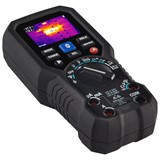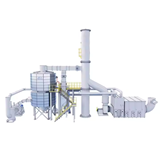Thermal imaging technology has revolutionized various industries, offering valuable insights and capabilities that were previously unimaginable. In this comprehensive article, we will delve into the workings of thermal imaging cameras, explore the different types available, discuss their applications in various industries, highlight key features and specifications to consider when purchasing one, and finally, provide a guide on budgeting for your thermal imaging cameras.
1) How Thermal Imaging Technology Works In Thermal Imaging Cameras
Thermal imaging cameras, also known as infrared cameras, utilize infrared radiation to create images based on the temperature variations of objects and surfaces. The basic principle behind these cameras lies in the detection of infrared energy emitted or reflected by an object.
Every object emits infrared radiation in the form of heat. The thermal imaging camera captures this emitted radiation and converts it into a visible image, displaying different colors or shades to represent various temperatures. The camera's sensor detects the infrared radiation, and a processor translates the data into a thermal image, which is then displayed on the camera's screen.
One of the key components of a thermal imaging camera is the microbolometer sensor. This sensor is sensitive to infrared radiation and converts the heat signatures into electrical signals. The camera's optics focus the infrared radiation onto the sensor array, and each sensor element corresponds to a pixel on the final image.
With thermal imaging technology, you can detect temperature variations and anomalies, making it an invaluable tool in numerous applications.
2) Different Types of Thermal Imaging Cameras (Handheld, Fixed, etc.)
Thermal imaging cameras come in various types, each designed to cater to specific needs and applications. Here are some of the most common types.
a) Handheld Thermal Imaging Cameras
Handheld thermal imaging cameras are compact and portable devices that offer convenience and ease of use. They are widely used for inspections, troubleshooting, and safety checks in industrial, electrical, and mechanical environments. Handheld models often come equipped with features like image capture, data storage, and wireless connectivity for real-time analysis.
b) Fixed Thermal Imaging Cameras
Fixed thermal imaging cameras are more permanently installed devices used for continuous monitoring and surveillance. These cameras are commonly employed in security and perimeter monitoring to detect intrusions, monitor temperature-sensitive processes, and ensure safety in critical infrastructures.
c) Pan-Tilt-Zoom (PTZ) Thermal Cameras
PTZ thermal cameras combine the benefits of thermal imaging with the ability to pan, tilt, and zoom. They are commonly used in security and surveillance applications, allowing operators to focus on specific areas of interest and track moving objects effectively.
d) Smartphone Thermal Imaging Cameras
In recent years, some smartphones have integrated thermal imaging capabilities, providing users with a pocket-sized thermal camera. While not as sophisticated as dedicated thermal imaging devices, smartphone thermal cameras are useful for basic tasks and quick inspections.
3) Applications and Industries Benefiting from Thermal Imaging Cameras
The versatility of thermal imaging cameras makes them indispensable in numerous industries. Let's explore some of the key applications and sectors that benefit from this technology:
a) Building Inspections and Energy Auditing
Thermal imaging cameras are extensively used in building inspections to identify energy inefficiencies, moisture intrusion, and structural defects. By detecting areas of heat loss or air leakage, these cameras help improve building energy efficiency and reduce utility costs.
b) Electrical Inspections
In the electrical industry, thermal imaging cameras are employed to identify hotspots in electrical panels, transformers, and other components. Detecting such hotspots can prevent potential electrical failures, reduce downtime, and enhance overall electrical system reliability.
c) Mechanical Inspections
In mechanical applications, thermal imaging cameras assist in detecting anomalies in machinery, such as overheating bearings or malfunctioning components. Regular inspections using thermal imaging technology can prevent unexpected breakdowns and costly repairs.
d) Firefighting and Search and Rescue
Thermal imaging cameras are vital tools for firefighters and search and rescue teams. They help locate heat signatures, detect victims in smoke-filled environments, and identify potential fire hazards, improving the efficiency and safety of rescue operations.
e) Industrial Process Monitoring
In industrial settings, thermal imaging cameras play a crucial role in monitoring processes that involve temperature-sensitive materials. They ensure that machinery operates within specified temperature ranges, helping maintain product quality and process efficiency.
f) Wildlife Observation
Biologists and researchers utilize thermal imaging cameras to study wildlife behavior and track animal movements in various habitats. These cameras enable non-intrusive observation and provide valuable data for conservation efforts.
4) Key Features and Specifications to Consider in Thermal Imaging Cameras
When selecting a thermal imaging camera, several essential features and specifications should be considered:
a) Thermal Resolution
Thermal resolution determines the camera's ability to detect small temperature differences accurately. Higher thermal resolution results in clearer and more detailed images, allowing for better analysis and identification of potential issues.
b) Sensitivity
Camera sensitivity is crucial for detecting low-temperature differences. A camera with higher sensitivity can identify subtle thermal variations, making it suitable for applications where precision is essential.
c) Field of View (FOV)
The camera's field of view defines the area that the camera can capture in a single image. A wider FOV is advantageous for monitoring large areas, while a narrower FOV is preferable for focusing on specific details.
d) Image and Video Storage
The capacity to capture and store thermal images and videos is essential for documentation and later analysis. Consider cameras with sufficient internal memory or external storage options.
e) Temperature Range
Thermal imaging cameras have specific temperature ranges they can detect. Choose a camera with a temperature range appropriate for your intended applications.
f) Image Modes and Palettes
Different image modes and palettes provide various ways to display thermal data, such as grayscale, rainbow, and iron bow. The ability to switch between these modes allows for better visualization and interpretation of thermal images.
5) Selecting the Right Thermal Resolution and Sensitivity for Thermal Imaging Cameras
Selecting the appropriate thermal resolution and sensitivity for your thermal imaging camera largely depends on the specific tasks and applications you intend to undertake. High-resolution cameras with superior sensitivity are ideal for tasks that require precise temperature measurements and detailed image analysis.
For building inspections and energy auditing, where identifying subtle temperature variations is crucial, a camera with higher thermal resolution and sensitivity is recommended. Similarly, in industries where machinery maintenance and reliability are paramount, such as electrical and mechanical inspections, opting for a camera with superior thermal capabilities is essential.
On the other hand, if your requirements involve broader surveillance and monitoring, cameras with slightly lower thermal resolution may suffice, as they can cover larger areas more efficiently.
6) Comparing Brands and Models of Thermal Imaging Cameras
When comparing different brands and models of thermal imaging cameras, several factors should be taken into account:
a) Reputation and Reliability
Research the reputation and reliability of various camera brands. Look for customer reviews, ratings, and testimonials to gauge user satisfaction.
b) Technical Support and Warranty
Consider the technical support and warranty offered by the manufacturers. Reliable after-sales service and a comprehensive warranty can ensure peace of mind and timely assistance if issues arise.
c) Software and Connectivity
Check the camera's software capabilities and compatibility with various devices and platforms. Easy-to-use software and versatile connectivity options enhance the camera's usability and data sharing capabilities.
d) Price and Budget
Set a budget for your thermal imaging camera purchase and compare models within your price range. While higher-end models may offer advanced features, they may not always be necessary for your specific applications.
7) Budgeting for Your Thermal Imaging Cameras Purchase
Budgeting for your thermal imaging camera purchase involves striking a balance between your needs and the available options within your budget. Here are some budgeting tips:
a) Assess Your Needs
Begin by evaluating your specific requirements and the intended applications of the thermal imaging camera. Determine the essential features and specifications necessary for your tasks.
b) Prioritize Quality
While budget constraints are a factor, it is essential to prioritize camera quality and reliability over cost alone. Investing in a reputable and durable camera ensures better performance and longevity.
c) Consider Future Upgrades
If possible, opt for a thermal imaging camera that allows for future upgrades or modular additions. This approach allows you to enhance the camera's capabilities without needing to purchase an entirely new unit
d) Explore Financing Options
If the ideal camera exceeds your immediate budget, consider exploring financing options. Many suppliers offer financing plans that can help you acquire the camera you need without straining your finances.
Conclusion
In conclusion, thermal imaging cameras are powerful tools with a myriad of applications across various industries. Understanding how thermal imaging technology works, the different types of cameras available, their applications, and the key features to consider will help you make an informed decision when choosing the right camera for your needs.
Remember to prioritize quality and suitability for your intended applications over price alone. By investing in a reliable and high-performing thermal imaging camera, you can gain a competitive edge in your field and ensure the success of your endeavors.
So, whether you're conducting building inspections, ensuring electrical system reliability, monitoring industrial processes, or embarking on wildlife observation, a thermal imaging camera can undoubtedly elevate your capabilities and leave others behind in the dust.
Don't hesitate to explore the diverse options available and choose the thermal imaging camera that best aligns with your requirements. With the right thermal imaging camera by your side, you'll be equipped to conquer challenges and unlock new opportunities in your professional journey.


















